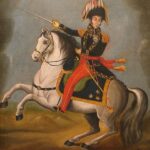![]()
Harold Arlen wrote “I’ve Got the World on a String” for a revue produced at a famous Harlem nightclub, the Cotton Club, which was owned by individuals of questionable character and even more questionable activities.
It featured black performers but served a virtually all-white and wealthy clientele that was attracted to the club by its excellent floor shows (revues) and its bootleg liquor, amply supplied by the proprietors. Arlen and his lyricist Ted Koehler had been affiliated with this flourishing establishment since 1930, and several songs written for Cotton Club revues by Arlen and Koehler became published hits, among them “Between The Devil And The Deep Blue Sea” (1931), “I Gotta Right To Sing The Blues” (1932), the classic “Stormy Weather” (1933), and “As Long As I Live” (1934).
The mood of this joyous song stands in marked contrast to the situation that prevailed in the United States at the time it was composed and performed, a situation that affected almost everyone, excluding, perhaps, a select group that no doubt included the patrons of the Cotton Club and its proprietors. Still, in what can be seen in retrospect either as typically American optimism or as an obtuse failure to recognize realities, initiatives were taken that looked beyond the Great Depression to a happier future. One example is the 1932 opening of Radio City Music Hall in Rockefeller Center, which, with 6,200 seats, became the world’s largest movie palace. And American humor did not go out of fashion with the Depression.
In her first movie, Night after Night (1932), Hollywood sex symbol Mae West responded to the compliment “Goodness, what beautiful diamonds” with “Goodness had nothing to do with it.” It is in this context that “I’ve Got the World on a String” earned a lasting position in American popular song as a symbol of humor, resilience, optimism, and the universality of human experience in the celebration of romantic love.
Although Ted Koehler’s lyrics, both in this song and in others by Arlen, may lack the sophistication and refinement of, say, a Lorenz Hart or a Cole Porter, they represent a directness and make such clever use of vernacular phrases that they were and are attractive and memorable. The verse speaks of the need for a “special phrase,” and that turns out to consist of the opening lines, “I’ve got the world on a string” and “Sittin’ on a rainbow,” where the vernacular contraction “sittin’” works perfectly with the long-short rhythm that pervades the melody of the song.
Even Cole Porter was not averse to using such vernacular expressions to achieve a joyously carefree effect in his lyrics, as in the title phrase of his song “Ridin’ High” from the 1936 musical Red, Hot and Blue. Because of the ecstatic nature of the lyrics, we must excuse some loose syntactic ends here and there.
For example, what is the subject of “may express,” in the fifth line of the lyrics? Those who regard the posing of this question as an egregious instance of pedantry may well be justified. After all, “express” rhymes, internally, with “happiness,” which is the main idea of the song. Who could ask for anything more, especially since the refrain contains such affective sonic connections as the alliterative chain that derives from the keyword “string”: “sittin’,” “song,” “sing,” and “silly so-and-so,” not to mention the ingenious inner-rhyming “string” and “finger” and the charming remote correspondence of “rainbow” in line 2 and “rain go” in line 7.
And, perhaps the one feature that places Koehler’s lyrics among the memorable of the period, in addition to the titular phrase itself, is the strategic delay of the kernel idea until the final line: “I’m in love.” Thus, the raison d’être of the title phrase “I’ve Got the World on a String” at the song’s beginning occurs only at the very end of the first period and in corresponding locations twice more.







